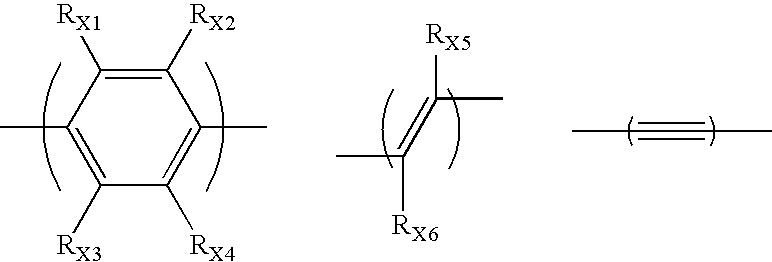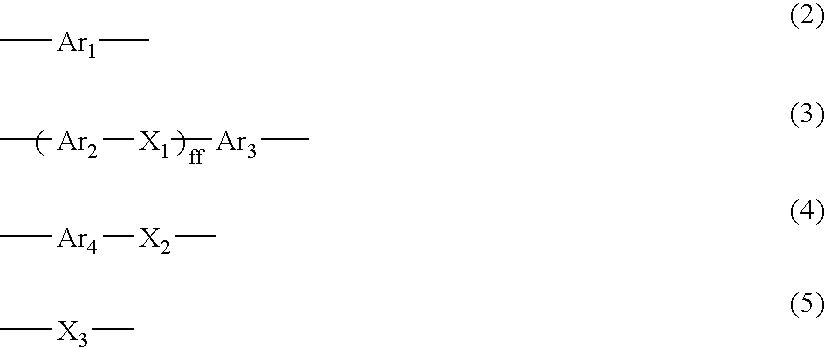Polymer Material and Device Using the Same
- Summary
- Abstract
- Description
- Claims
- Application Information
AI Technical Summary
Benefits of technology
Problems solved by technology
Method used
Image
Examples
example 1
[0223]Prepared was 1.8 wt % toluene solution of the mixture in which the following Polymer Compound I-1 was added with the following Dendrimer (D-1) in an amount of 40 wt %.
[0224]On a glass substrate having ITO film of 150 nm thick formed with a sputtering method, a film was formed in a thickness of 50 nm with a spin coating with using a poly(ethylenedioxythiophene) / polystyrene sulfonic acid solution (Bayer A.G. BaytronP), and then dried on a hot plate at 200° C. for 10 minutes. Thereafter, with using the above-prepared chloroform solution, a film was formed with a spin coating at a rotation speed of 1000 rpm. The resulting film thickness was 100 nm. Furthermore, this film, after being dried under a reduced pressure at 80° C. for 1 hour, was vapor-deposited with LiF with about 4 nm thick as a cathode buffer layer, calcium with about 5 nm thick as a cathode, and subsequently aluminum with about 80 nm thick to produce an EL device. Herein, the metal vapor-deposition was commenced afte...
example 2
[0231]After preparing 1.5 wt % toluene solution of the mixture in which the above-mentioned Polymer Compound 1-1 was added with the following Dendrimer (D-2) in an amount of 2 wt %, a device was produced in the same manner as in Example 1. A rotation number of a spin coater at the time of forming a film was 2000 rpm, and a film thickness was about 95 nm. With applying a voltage to the device obtained, an EL light emission having a peak at 625 nm was obtained. The device exhibited a light emission of 100 cd / m2 at about 10 V. In addition, the maximum light emission efficiency was 4.9 cd / A.
A lowest excited triplet energy of Dendrimer (D-2) obtained in the same manner as in Example 1 was 2.3 eV. For the calculation, the following molecule (D-2M) was used as a model. Model dendrimer (D-2M)
[0232]Dendrimer (D-2) was synthesized according to the method disclosed in WO02 / 066552.
example 3
[0233]After preparing 1.0 wt % toluene solution of the mixture in which the following Polymer Compounds (1-2) and (3-1) and Dendrimer (D-2) described in Example 2 were mixed in a ratio (weight ratio) of 76:19:5, a device was produced in the same manner as in Example 1. A rotation number of a spin coater at the time of forming a film was 2200 rpm, and a film thickness was about 90 nm.
[0234]With applying a voltage to the device obtained, an EL light emission having a peak at 625 nm was obtained. The device exhibited a light emission of 100 cd / m2 at about 5 V. In addition, the maximum light emission efficiency was 4.7 cd / A.
[0235]Polymer Compound (1-2) was synthesized according to a method disclosed in Kokai (Japan unexamined patent publication) No. 2004-143419. The polystyrene-reduced number-average molecular weight of this Polymer Compound (1-2) was Mn=1.2×104, and the weight-average molecular weight was Mw=7.7×104. Polymer Compound (3-1) was synthesized according to a method disclose...
PUM
| Property | Measurement | Unit |
|---|---|---|
| Temperature | aaaaa | aaaaa |
| Viscosity | aaaaa | aaaaa |
| Length | aaaaa | aaaaa |
Abstract
Description
Claims
Application Information
 Login to View More
Login to View More - R&D
- Intellectual Property
- Life Sciences
- Materials
- Tech Scout
- Unparalleled Data Quality
- Higher Quality Content
- 60% Fewer Hallucinations
Browse by: Latest US Patents, China's latest patents, Technical Efficacy Thesaurus, Application Domain, Technology Topic, Popular Technical Reports.
© 2025 PatSnap. All rights reserved.Legal|Privacy policy|Modern Slavery Act Transparency Statement|Sitemap|About US| Contact US: help@patsnap.com



